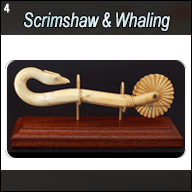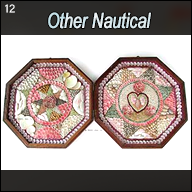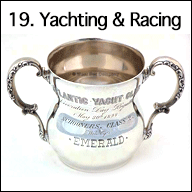U.S. Navy Museum - Significant Naval Artifacts
This section will be of benefit to our customers who have an interest in early U.S. Navy history and in the rarely encountered Naval relics which remain from the 19th and early 20th centuries.
(These items are NOT for sale.)
 |
EARLY U.S. NAVY CLINOMETER. A museum piece! A rare Naval relic which was produced immediately following the American Civil War. It is embodied in a large functional mechanical inclinometer. The scale is beautifully hand-engraved in the most handsome script “U.S. Navy Yard Washington 1871.” This impressive device is made of thick solid brass mounted onto its original solid teak backboard. The precisely calibrated scale indicates degrees of heel (or list) port and starboard from 0 – 35 in single degree increments, marked by 5’s. The ingenious construction of this instrument allows the heavily weighted brass plumb bob to pass over the scale while being damped in its motion by the secondary articulated bob above. This clever arrangement allowed a real time read-out of the ship’s stance at the moment of observation, without deflection or vibration. The instrument itself measures 20 inches high by 11 ¼ inches wide. Its backboard is 23 ½ inches tall by 11 ¾ inches wide. Excellent original condition in all respects. There is no such relic better preserved! |
CRUISE BOOK: "SOUVENIR U.S. FLAG SHIP PENSACOLA"
Rare and historic 19th century hard-bound book entitled "SOUVENIR U.S. FLAG SHIP PENSACOLA CAPT. GEORGE DEWEY." as embossed in gold on the blue cloth cover. The title page is entirely hand-drawn and lettered. It reads, "Souvenir of the Cruise of the U.S. FLAG SHIP PENSACOLA. Capt. George Dewey U.S.N. Commanding. and of her Official Inspection by the "BOARD OF INSPECTION AND SURVEY" Rear Admiral Jas. E. Jouett U.S.N. President at Hampton Roads, VA, Feb 23 & 24th 1888." This large format book measures 12 by 10 inches and contains 30 unnumbered pages on heavy, near card quality paper. Each page page is printed on one side only with revealing views of the ship, its interior, its men in daily life and shipboard drills. In addition to the title page there is a statistical page with ship facts and the itinerary of 29 ports it visited during the world cruise from April 5, 1885 to March 1, 1888. This book is very historic in that it documents the first such extended world cruise by a U.S. Naval vessel, predating the similar much heralded feat performed by the "Great White Fleet" fully 20 years later. Secondly, it documents the command of the famous then "Captain" George Dewey who went on to become the first 4 star Admiral in U.S. history owing to his victories in the Spanish-American War. And thirdly, it represents a forerunner of Navy ship "Cruise Books" which became a tradition much later, in the 20th century. As a "Souvenir" this book was obviously limited in production to those who actually served on the ship during the times specified, thus is one (if not the only one) of very few surviving! Good condition with expected minor wear to cover edges. Content excellent.
The USS PENSACOLA was a steam/sail frigate of 130 1/2 feet in length and 3,000 tons. She was launched by the Pensacola Navy Yard on August 15, 1859 and commissioned in December 1859. During the Civil War she was attached to Flag Officer Farragut's famous West Gulf Blockading Squadron. On April 24, 1862 she steamed with that fleet in the historic dash past Confederate forts St. Philip and Jackson which protected New Orleans. That action prompted Farragut's famous "Damn the Torpedos Full Speed Ahead" order. During the next two years, she helped guard the lower Mississippi, returning to New York Navy Yard where she was decommissioned in April 1864 for the installation of new and improved machinery. Recommissioned in August 1866, Pensacola sailed round Cape Horn to join the Pacific Squadron where she continued duty until June 1883 when she returned to Norfolk, Virginia. In April 1885 PENSACOLA began the world cruise documented in this book, returning to home port in February 1888. She decommissioned at Mare Island in April 1892 but was recommissioned at the onset of the Spanish-American War in November 1898, serving as a training ship until May 1899. Her final days were spent as a receiving ship at Yerba Buena Island Training Station, San Francisco until she was struck from the Navy Register on December 23, 1911. Subsequently burned and sunk by the Navy in San Francisco Bay near Hunter's Point in early May 1912, ironically PENSACOLA met her demise just one month after TITANIC.
SCARCE LATE 19TH CENTURY ENGINEROOM CLOCK FROM A U.S. NAVY MONITOR
Large solid bronze ship's clock with the silvered dial engraved "U.S.S. TERROR" and faintly stenciled "ENGINEROOM." Case made by the Ashcroft MFG Co., New York, the movement made by E. Howard & Co., Boston.
USS TERROR was a 3990 ton monitor laid down at the Philadelphia Navy Yard in 1874 and completed by the New York Navy Yard in 1896. She was commissioned in April 1896 and spent her first two years operating off the East Coast of the U.S. During the Spanish-American War, TERROR actively served in the Caribbean and participated in the bombardment of San Juan, Puerto Rico on May 12, 1898. She served as a training ship at the U.S. Naval Academy at the turn-of-the-century.
RARE U.S. NAVY BATTLESHIP COFFEE POT BEAUTIFULLY AND BOLDLY HAND-ENGRAVED WITH AN AMERICAN EAGLE CLUTCHING ARROWS AND AN OLIVE BRANCH ABOVE THE LETTERS "U.S.N." CIRCA 1890
From an American Naval ship-of-the-line during the 4th quarter of the 19th C. The bottom is marked "Wilcox 00 IS" while the spout is marked "PATD OCT 29th, 1878." The inside of the pot contains an insulating porcelain liner. According to a noted Naval historian only 48 of these "special coffee pots" were ever produced for the Navy by Reed & Barton, Wilcox and Wallace silver plate companies from the late 1870's. All were made for captains of capital ships (battleships) and Admirals' messes. One such pot is now in the collection of the Naval History Museum at the U.S Naval Academy, Annapolis, Maryland.
RARE PRE-CIVIL WAR SHIP'S BOAT COMPASS BY "ROBERT MERRILL, NEW YORK" EXTERIOR OF BOX STENCILED "U.S. NAVY." CIRCA 1855.
Such boxed compasses were standard equipment in the larger Navy ship's boats which required over- the-horizon navigation. Robert Merrill began business in New York as a "Mathematical Instrument Maker" in 1835. He continued at various addresses until 1860 when he took his son into partnership and the firm name changed to "Robert Merrill & Son."
VERY RARE SHIP'S BATTLE RATTLE ALARM FROM THE AMERICAN SAILING NAVY MARKED "PATENTED NOV 07 1866, USN." CIRCA 1866.
By swinging the weighted end on its pivot a loud clacking noise was produced. Such hand-held alarms were used by the ship's lookouts to alert the crew to enemy action or imminent danger.
RARE SHIP'S WATCH GLASS TIMER FROM THE AMERICAN SAILING NAVY STENCILED "U.S. NAVY" CIRCA 1850.
Blown glass vial filled with sand, turned oak ends with decorative spindles. The passage of sand marked one half hour, or a 1/8th segment of a 4 hour watch on deck. With each passage of sand a crewman rang the ship's bell successively, first once, and finally 8 times. Today's "ship's bell" clocks strike in the same manner.
MEXICAN WAR ERA AMERICAN SAILOR'S POWDER FLASK EMBOSSED IN HIGH RELIEF "U.S.N." CIRCA 1845
Heavy molded copper Navy powder flask with brass fittings. This flask holds 14 ounces of powder and would have dispensed a charge of about 65 grains into a muzzle loaded weapon.
VERY RARE SAIL MAKER'S PALM FROM THE AMERICAN SAILING NAVY CIRCA 1840.
Used on the palm of the hand to drive a stout sail maker's needle through heavy sail canvas. A similarly marked spread winged American eagle perched on crossed arrows is found on the Model 1841 Naval Cutlass Short Sword.
RARE CIVIL WAR ERA NAVY ISSUE SAILOR'S WORKING POCKET KNIFE. BLADE IS SIGNED "JOSEPH JEFFRIES" AND IS BOLDLY MARKED "U.S. NAVY". CIRCA 1865.
This classic seaman's knife allowed the deck hand to cut and splice line, whittle and perform a variety of other shipboard tasks, but did not afford him the opportunity to use it as a weapon against his shipmates in the confined and often rowdy quarters of the ship's foc'sle.
UNUSUAL NAVAL WAR PRIZE FROM the SPANISH-AMERICAN WAR INSCRIBED IN HAND-WRITTEN INK ON THE BRASS SHELL CASING.
"One Pound Shell Taken from the Spanish Gunboat SANDOVAL in Harbor of Guanatanamo (sic) On July 4 - 1898."
CIVIL WAR ERA SAILOR'S ISSUE SHAVING KIT EMBOSSED "U.S.N., DON'T GIVE UP THE SHIP" CIRCA 1860
Hard vulcanized rubber container for shaving soap. Mirror in lid with suspension loop for hanging. Marked "Manufactured by the Novelty Rubber Company Co., Brunswick, New Jersey, Under Goodyear's patent May 6, 1852."
"U.S.N." PORCELAIN SOAP DISH CIRCA 1900
Hard fired oval porcelain soap dish with the glazed inscription "U.S.N." on the side. U.S. Navy issue, era of the "Great White Fleet.
VERY RARE UNIFORM INSIGNIAS FOR AN ENLISTED AMERICAN SAILOR AS WORN PRIOR TO AND DURING THE CIVIL WAR.
Prior to 1866 a sleeve mark was used only to indicate petty officers as a group with no indication of rating. The emblem, introduced in 1841, was comprised of a downward pointing star above a spread-winged eagle perched on a fouled anchor and was worn on the right sleeve below the shoulder. A separate emblem indicating rate was worn on both sleeves above the wrists. In this rare example the rating badge is for a "Gunner's Mate" and consists of two crossed cannons, muzzles down.
ORIGINAL LATE 19TH CENTURY ALBUMEN PHOTOGRAPH OF THE USS HOLLAND THE UNITED STATES NAVY'S FIRST COMMISSIONED SUBMARINE UNDERWAY FOR SEA TRIALS.
The USS HOLLAND namesake of its inventor John P. Holland, was launched by Crescent Shipyards, Elizabeth, New Jersey in 1898 and commissioned on October 12, 1900. She was 54 feet in length with a displacement of 64 tons, and had a compliment of 7 men. Built essentially for experimental purposes, she was used for a time training cadets at the U.S. Naval Academy in the new science of submarine warfare.HOLLAND was struck from the Navy register of ships on November 21, 1910 already obsolete in just over 10 years!


























